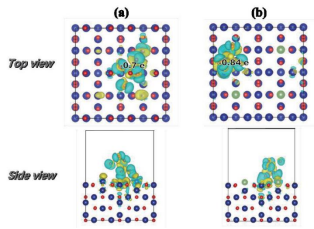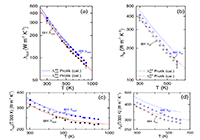(1)定义:晶体中的热传导可以有两种机构,即导电电子的热传导以及由晶格振动引起的热传导(声子热传导),由后者所引起的热导率称之为晶格热导率,晶格热导依赖于声子来完成。
(2)作用:晶格热导率决定了热能在固体中的传输,影响着热电材料的性能,是新型热电材料研究中的重要指标。
(3)说明:The ^ and the scaled ^(T/300 K) of 4H and 6H SiC between 300 and 850 K are shown in Fig. 7. Across the full temperature range, 4H SiC shows higher ^ than 6H SiC; for both polytypes, ^in is larger than ^out, consistent with previous studies [54,56]. At 300 K, ^out = 345 and 320 W m−1 K−1; at 850 K, ^out = 85 and 78 W m−1 K−1 for 4H and 6H SiC, respectively. At 300 K, ^in = 415 and 390 W m−1 K−1; at 600 K, ^in = 150 and 140 W m−1 K−1 for 4H and 6H SiC, respectively. (We fitted the measured ^ of GaN and both 4H and 6H SiC with an empirical equation for engineering usage in Table SI in Supplemental Material [70].) The Debye temperature of SiC is high, ^D ≈ 1200 K [49]. Thus, ^ of SiC shows a change of slope at T < 600 K in these log-log plots due to the onset of exponential temperature dependence of umklapp scattering rates at low temperatures. At 600 < 850 K, ^ ∝ T −1.2 and ^ ∝ T −1.1 for 4H and 6H SiC, respectively, which is less rapid compared with ^ ∝ T −1.5 in GaN in this temperature range. This can also be seen in the relatively flat curve at high temperature in Fig. Across the temperature range 300 to 850 K, ^ of GaN is 60–70% of the value of thermal conductivity of 4H and 6H SiC.
文献来源:DOI: 10.1103/PhysRevMaterials.3.014601

第一性原理计算的基本思想是将多个原子构成的体系看成是由多个电子和原子核组成的系统,并根据量子力学的基本原理对问题进行最大限度的“非经验性”处理。它只需要5个基本常数(m0,e,h,c,kB)就可以计算出体系的能量和电子结构等物理性质。它可以确定已知材料的结构和基础性质,并实现原子级别的精准控制,是现阶段解决实验理论问题和预测新材料结构性能的有力工具。并且,第一性原理计算不需要开展真实的实验,极大地节省了实验成本,现已被广泛应用于化学、物理、生命科学和材料学等领域。
适合的研究方向包括但不限于:催化、电池、半导体、金属材料、非金属材料、合金、纳米材料等
可以计算的体系包括但不限于:晶体、非晶、二维材料、表面、界面、固体等
常用软件:VASP,MS,CP2K,QE等
可以计算的内容包括但不限于:
材料的几何结构参数(如键长、键角、二面角、晶格常数、原子位置等)
材料的电子结构信息(如电荷密度、电荷差分密度、态密度、能带、费米能级、功函数、ELF等)
材料的光学性质(如介电常数等)
材料的力学性质(如弹性模量等)
材料的磁学性质(如磁导率等)
材料的晶格动力学性质(如声子谱等)
材料的表面性质(如吸附能,催化计算等)
复合材料的性质(异质结等内容)等等



